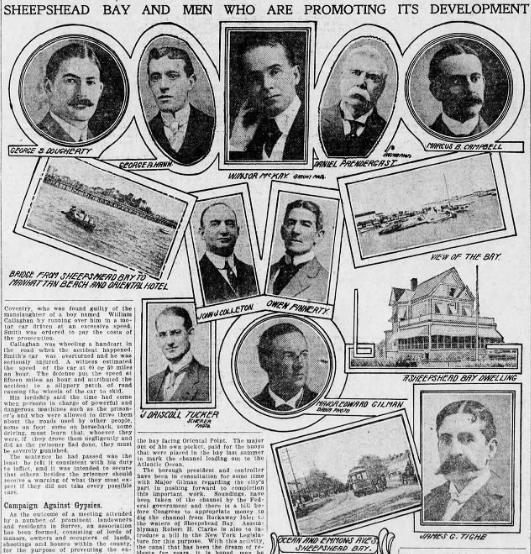Sheepshead Bay Yearned For Development A Century Ago

Would you believe that Sheepshead Bay residents used to exert a significant amount of their effort in pushing for wealthy real estate developers to invest in the neighborhood? Well it’s true, according to a Brooklyn Daily Eagle issue from March 7, 1909.
“[Sheepshead Bay], the former fishing village, and known all over the world as the home of the finest race track in America, to now take its turn in the way of development,” reads the article. “And exploit the natural advantages and beauties of the town in a manner that should be productive of good results, for the men of affairs who have the work in hand are all known as energetic and men who do things.”
At the time, it was widely believed the horse racing business that flourished in Sheepshead Bay was doomed. So the Board of Trade and Improvement Association “devised schemes” to let people know “what great future they believe is in store for people buying properties in that section,” according to the article.
Among the reasons this article pushed for coming to Sheepshead Bay was the planned widening of Coney Island Creek. They planned on calling it the Gravesend Ship Canal, and it would have let yachts through to Sheepshead Bay, and then into Jamaica Bay. The canal, however, never came to fruition. The development they longed for certainly did, though.
A main advocate for the canal, and for development in Sheepshead Bay, then a small fishing town, was Major E.R. Gillman. Gillman was a “yachtman,” and a civil engineer who made his living making trolley roads. He lived on the bay and once paid for buoys that marked a channel to the Atlantic Ocean from the bay.
Another commodity that the writer of the article mentioned was the Ocean Avenue footbridge. Back then, it was made out of wood. There were plans of converting it into a steel drawbridge that would allow boats through, but that never happened either.
The next attraction mentioned was hotels and boarding houses in Sheepshead Bay that could house racers in the boat races, and “tens of thousands” of race spectators.
“What more beautiful place could be found, they argue, with clear still water, and no interfering with traffic,” reads the article. Clear water? How times have changed.
They also planned on holding a marathon at the old Sheepshead Bay race track, which the article said would have been an “international affair.” We couldn’t find out if that race ever happened, but we know the development it was supposed to draw definitely happened.
There was even a pamphlet printed with a birds-eye-view of Sheepshead Bay on the cover that was given to the wealthy men of the city, and placed in yacht clubs. The objective of the pamphlet was to bring the “best class of people,” and to show that Sheepshead Bay had more to offer than just the race track.
The group that was mainly behind the effort to develop Sheepshead Bay was the Press Committee. Comodore Coneys was the chairman, and the other important members were Messrs Colleton, Owen Finnerty, Robert Clarke, George Hann, Joseph Woolrich, Daniel Prendergast, Marcus B. Campbell, and Winsor McCay.
The article also boasts of the modernity of its sewage system. Supposedly, Sheepshead Bay was the first neighborhood in the area to get a sewer with a disposing plant that got rid of the refuse, according to the article. Also, at the time, Sheepshead Bay had a brand new, state-of-the-art firehouse, and a roster of very wealthy residents to convince people it’s worth living there.
Could you imagine any community in Brooklyn pushing for new development, and more wealthy people in their neighborhoods today? We certainly can’t.




